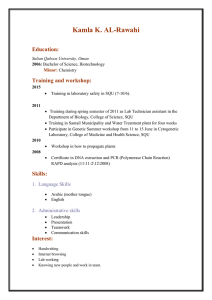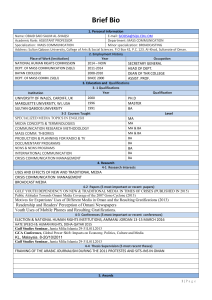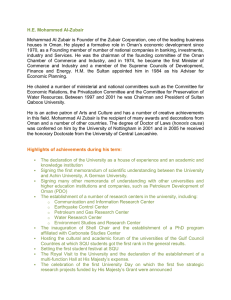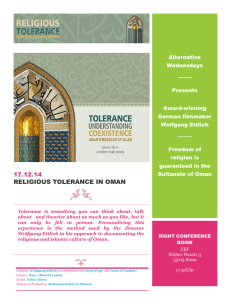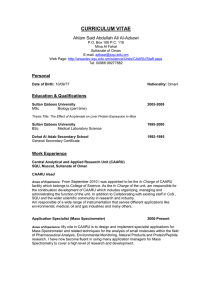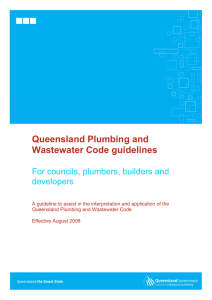– “AMAL” Study
advertisement
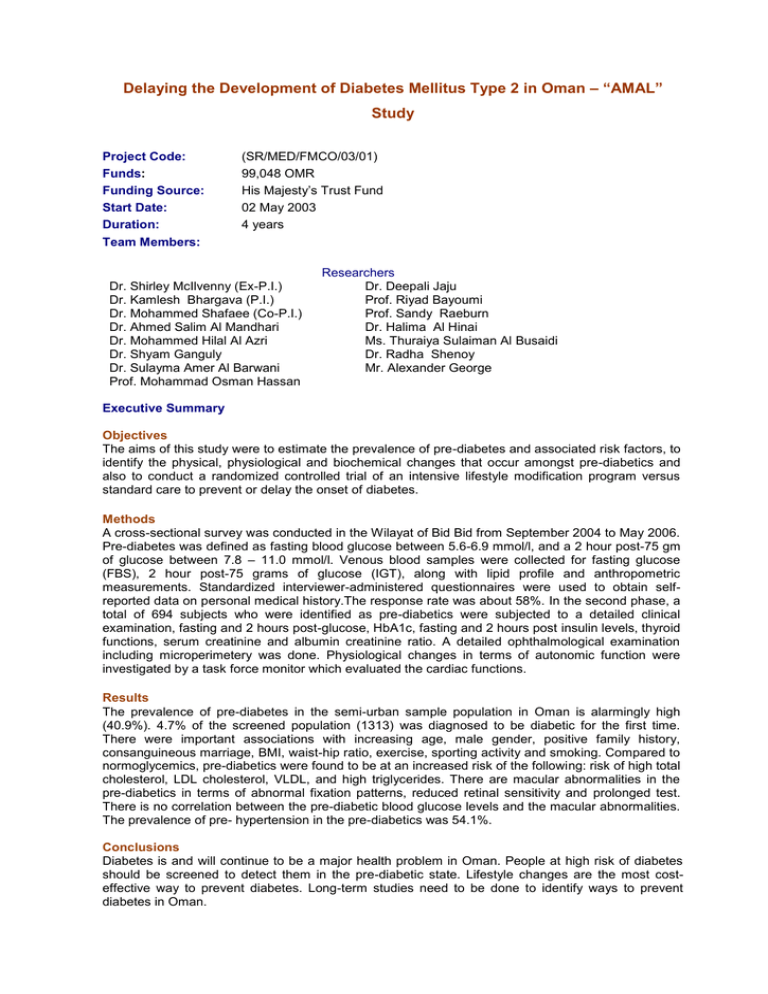
Delaying the Development of Diabetes Mellitus Type 2 in Oman – “AMAL” Study Project Code: Funds: Funding Source: Start Date: Duration: Team Members: (SR/MED/FMCO/03/01) 99,048 OMR His Majesty’s Trust Fund 02 May 2003 4 years Dr. Shirley McIlvenny (Ex-P.I.) Dr. Kamlesh Bhargava (P.I.) Dr. Mohammed Shafaee (Co-P.I.) Dr. Ahmed Salim Al Mandhari Dr. Mohammed Hilal Al Azri Dr. Shyam Ganguly Dr. Sulayma Amer Al Barwani Prof. Mohammad Osman Hassan Researchers Dr. Deepali Jaju Prof. Riyad Bayoumi Prof. Sandy Raeburn Dr. Halima Al Hinai Ms. Thuraiya Sulaiman Al Busaidi Dr. Radha Shenoy Mr. Alexander George Executive Summary Objectives The aims of this study were to estimate the prevalence of pre-diabetes and associated risk factors, to identify the physical, physiological and biochemical changes that occur amongst pre-diabetics and also to conduct a randomized controlled trial of an intensive lifestyle modification program versus standard care to prevent or delay the onset of diabetes. Methods A cross-sectional survey was conducted in the Wilayat of Bid Bid from September 2004 to May 2006. Pre-diabetes was defined as fasting blood glucose between 5.6-6.9 mmol/l, and a 2 hour post-75 gm of glucose between 7.8 – 11.0 mmol/l. Venous blood samples were collected for fasting glucose (FBS), 2 hour post-75 grams of glucose (IGT), along with lipid profile and anthropometric measurements. Standardized interviewer-administered questionnaires were used to obtain selfreported data on personal medical history.The response rate was about 58%. In the second phase, a total of 694 subjects who were identified as pre-diabetics were subjected to a detailed clinical examination, fasting and 2 hours post-glucose, HbA1c, fasting and 2 hours post insulin levels, thyroid functions, serum creatinine and albumin creatinine ratio. A detailed ophthalmological examination including microperimetery was done. Physiological changes in terms of autonomic function were investigated by a task force monitor which evaluated the cardiac functions. Results The prevalence of pre-diabetes in the semi-urban sample population in Oman is alarmingly high (40.9%). 4.7% of the screened population (1313) was diagnosed to be diabetic for the first time. There were important associations with increasing age, male gender, positive family history, consanguineous marriage, BMI, waist-hip ratio, exercise, sporting activity and smoking. Compared to normoglycemics, pre-diabetics were found to be at an increased risk of the following: risk of high total cholesterol, LDL cholesterol, VLDL, and high triglycerides. There are macular abnormalities in the pre-diabetics in terms of abnormal fixation patterns, reduced retinal sensitivity and prolonged test. There is no correlation between the pre-diabetic blood glucose levels and the macular abnormalities. The prevalence of pre- hypertension in the pre-diabetics was 54.1%. Conclusions Diabetes is and will continue to be a major health problem in Oman. People at high risk of diabetes should be screened to detect them in the pre-diabetic state. Lifestyle changes are the most costeffective way to prevent diabetes. Long-term studies need to be done to identify ways to prevent diabetes in Oman. Investigation of Hydrogen Induced Cracking of Metals in Aqueous Media Containing Sulphide Ions Project Code: Funds: Funding Source: Start Date: Duration Team Members: (SR/SCI/CHEM/03/01) 45,000 OMR His Majesty’s Trust Fund 02 May 2003 4 years Researchers Dr. Ashraf Talib Al-Hinai, (P.I.) Dr. Emad Khudaish Dr. Ahmed Dhofar Al-Rawas Dr. Mohamed Elzain Dr. Abbasher Gismelseed Dr. Salim Humood Al-Harthi Dr. Mohammed Said Al-Busaidi Executive Summary Objectives Due to the lack of specialized infrastructure, establishing the first aqueous corrosion studies laboratory was the prime objective. After that, this facility would be used for research, training, and consultancies. As a primary goal, the lab started with studying the corrosion of metals in sulfidecontaining media. Methods To establish the optimum infrastructure for the lab, the research team consulted with several specialized local and international institutions. The lab was equipped with the required instruments to serve SQU and Omani industries. The training component was to be fulfilled through new corrosion courses offered to SQU students. In order to attract contracts and consultancies from industry, the research teams demonstrated the lab’s facilities to industry executives through personal contacts and visits. To study the corrosion of metals in sulfide-containing media, the team selected industrially important alloys and subjected them to accelerated corrosion conditions. Results SQU now owns a well-equipped aqueous corrosion testing facility, which integrates with the atmospheric corrosion lab, to offer the necessary training to SQU students. Also, SQU offers the required support to Omani industries. The corrosion studies course at SQU is now a popular course offered to Science and Engineering students. In addition to that, more that 15 students have performed their graduation projects in the facility. The research team recognized that the mechanical factors are of immense importance for corrosion in sulfide-containing media. The team is seeking expertise in this area from researchers in the College of Engineering. In collaboration with the College of Engineering, four interrelated corrosion research contracts were established with the Omani oil and gas industry. Conclusions The support granted from His Majesties Research Fund made it possible to establish solid infrastructure for aqueous corrosion studies at SQU. The research team ensured the best use of this generous grant and extended the benefit not just in the research direction, but also in the area of education, training and consultancy. Evaluation of Greywater Reuse Potential for Sustainable Water Resources Management in Oman – Phase I Project Code: Funds: Funding Source: Start Date: Duration: Team Members: (SR/AGR/BIOR/03/01) 97,000 OMR His Majesty’s Trust Fund 02 May 2003 4 years Researchers Dr. Sanmugam Prathapar (P.I.) Dr. Ahmad Jamrah Dr. Mushtaque Ahmed Dr. Hayder Abdelrahman Dr. Malik Mohamed Al Wardy Dr. Ahmad Yahya Al Maskri Dr. Hemesiri Kotagama Research Assistants Mr. Saif Salim Al Adawi Mr. Masoud Said Al Kindi Mr. Abdullah Said Al Belushi Graduate Students Mr. Ali Al Harassi Mr. Salim Khamis Al Sidiari Ms. Aamna Yasser Al Abri Mr. Mohammed Suheil Jashoul Executive Summary Objectives Oman is an arid country where groundwater reserves are under pressure. There is a need to identify alternative sources of water and develop appropriate technology to harness them to reduce pressure on freshwater reserves in Oman. One of the alternative sources of water is greywater. This project aimed to evaluate the potential of greywater as an alternative source of water in Oman. Methods In the first stage of the project, a review of refereed, un-refereed and grey literature on greywater treatment and reuse was carried out. Greywater use at over 200 households was estimated based on completed questionnaires and manufacturers’ specifications. Furthermore, greywater use at 12 houses was monitored for approximately six months. During this period, water quality analysis of greywater was also undertaken. During the second stage of the project, commercially available greywater treatment systems were installed at a domestic premise and a second one was installed at SQU mosque. In addition, a greywater treatment unit was constructed at the South Al Hail mosque using locally available material. A fourth bench scale treatment unit using Sequencing Batch Reactor (SBR) was assembled at SQU. Performance of all four units was monitored. In the final phase, guidelines for reuse of treated grey water based on the experimental results and on international literature were developed. In addition, a financial analysis to determine the Internal Rate of Return and Cost:Benefit ratios for various scenarios to install and operate greywater treatment systems was carried out. Results Volumes of greywater reuse monitored at houses compared satisfactorily with estimates made with questionnaire data and manufacturers’ specifications. Analysis showed that 84% of Omanis are in favor of treating and reusing greywater. Those not in favor of treated greywater reuse cited religion, health, environmental degradation, including groundwater contamination, and costs as reasons. In Oman, approximately 80% of the water used in houses is grey water. This is approximately 140 liters per person per day, and more than the per capita volume of greywater produced in Europe and Japan. Depending on the size of a mosque, ablution water available at mosques ranges from 1000 liters per day to 10,000 liters per day (Prathapar et al. 2005). Since there are more than 13,000 mosques in Oman, the reuse potential of ablution water is very high. Greywater and ablution water collected in Oman require chlorination to remove biological contaminants such as E. coli and coliforms. Since the suspended solids in Omani greywater and ablution water are high, they require filtration if pressurized irrigation methods are used for irrigation. Chlorination and sand filtration will be adequate to treat greywater from households if kitchen water and blackwater are not mixed with other greywater produced. Conclusions A custom-made treatment unit where filtration and chlorination are carried out will be financially and technically viable. Commercial greywater treatment systems are not financially viable for small mosques and small households. The Use of Geographical Information Systems and Remote Sensing to Monitor, Analyze and Model Urban Growth in Muscat Project Code: Funds: Funding Source: Start Date: Duration: Team Members: (SR/ART/GEOG/03/01) 47,000 OMR His Majesty’s Trust Fund 02 May 2003 3 years Researchers Dr. Talal Yousif Al-Awadhi (P.I.) Dr. Andy Kwarteng Dr. Ahmed Abdul-salaam Ali Mr. Mohammed Al-Barawani Mr. Khamis Al-Qasmi Mr. Nasser Mohamed Al-Namani Mr. Ghazi Ali Al-Rawas Research Assistants Mr. Nasserallah Sinad Al-Jabri Mr. Saif Mohamed Al-Rawahi Graduate Students Mr. Khalid Ahmed Al-Kalbani Mr. Mussalam Salim Al-Rahbi Mr. Hamad Khamis Al-Agbari Mr. Soud Salim Al-Nofali Mr. Bader Amir Al-Salmani Executive Summary Objectives The main objective of the project was to examine past, present and future trends in urban growth by using GIS and RS technologies. Other objectives were: (1) to study and to define temporal land use changes and all human activities in the Muscat area; (2) to create a digital spatial database in different resolutions, (3) to define and to classify the main factors behind urban growth in Muscat; (4) to propose and test several solutions to control this growth; (5) to deliver up-to-date land use maps for the area under study; and (6) to deliver several urban growth maps for ten year periods. Methods GIS & RS are widely used techniques in detecting, monitoring and predicting urban growth. In this study, two approaches were applied. The first approach was used for detecting and tracking land use change in the last 45 years. Six land use maps were digitized directly from aerial photographic and high resolution remote sensing satellite imagery for the years 1960, 1970, 1980, 1990, 2000 and 2003. The second approach concentrated on predicting urban growth in the next 50 years. For this purpose, the SLEUTH Model was selected. Results 2 The total built-up area in Muscat expanded by more than 840% from 23 km in 1960 to more than 192 2 km in 2003. The majority of expansion was in the period 1970 -1980 which registered an increase of 2 2 more than three-fold (from 23 km in 1970 to more than 76 km in 1980). There was no significant urban expansion before 1970. The actual annual urban expansion rate in the period 1960 – 2003 was 17.1% and the average built-up area is 393.8 hectares. It is also possible to identify the precise change in land-use categories over time. For example, a more than 170% increase in residential land took place from 1980 to 1990. More than 78% of green area could be lost to urbanization in the next 45 years. The project was also successful in identifying urban expansion in the future: it could reach 2 more than 341 km in 2050. The project was also able to draw the future urban expansion scenario which would proceed in the following sequence: (i) filling the gaps between existing built-up areas, (ii) expansion along the edges of existing settlements, (iii) expansion along the road network and (iv) the establishment of new satellite settlements around existing urban boundaries depending on suitability of slope and excluded areas as well as accessibility. Conclusions Muscat is the main active administrative center for the economy, politics, population and urbanization in the Sultanate. After reviewing all previous results, these activities may be intensified, which could affect the balance between Muscat and other administrative centers in Oman. This rapid urban growth will also lead to a number of urban problems that may affect the area and its roles such as greater immigration towards Muscat and a greater reduction in green areas. In addition, urban physical structure is expected to encroach on unsuitable areas such as wadi beds and mountain slopes and, hence, increase vulnerability to flood and mass movement hazards. In order to control and manage these problems in a sustainable manner, a rigorous, complete, integrated and detailed study should be carried out to highlight their range and dynamics.
